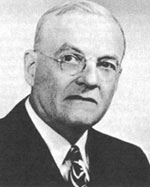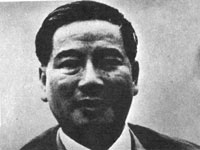CHAPTER 7
The Men Behind the Vietnamese War
The background to the oncoming Vietnamese War could not have been more somber or ominous. It was consonant with the fast deteriorating situation in Indo-China, where the French were being soundly defeated by the relentless Vietnamese guerrillas, and the U.S. had started to side with the French forces by sending them ever larger consignments of war materials.
Within a relatively short period American aid had become more than substantial. From 1950 to 1954, in fact, the U.S. had dispatched more than 400,000 tons of war material, 150,000 firearms, 340 airplanes and 350 warships as already quoted. Notwithstanding all this, however, the French were finally routed. There followed the Geneva Agreement, when the 17th Parallel, was defined as the "provisional" demarcation line between the Vietnam of the North and the Vietnam of the South, as we have already seen.
It was a fateful compromise. At that time however it appeared to be justified, in so far that it gave breathing space to the U.S. and to the signatories of the Geneva Convention. With good will on both sides, it was reasoned, a final and just solution would eventually be found. The Vietnamese people in the long run would decide for themselves what form of government they wanted by means of a general election as proposed by Geneva.
The compromise however, had been reached without taking into account the reality of the joint long range Asian strategy of the two major anti-Communist partners, the U.S. and the Vatican, which they had already set in motion behind the scenes. Their joint strategy as already indicated had been inspired and promoted by religious and ideological interests which transcended any localized conflict, no matter how strategically important.
The formulators were ready at hand on each side of the Atlantic. In Rome there was the most formidable and relentless anti-Communist crusader of the century, namely Pope Pius XII. In Washington there existed his political counterpart, the U.S. Secretary of State, John Foster Dulles. John Foster Dulles was the center of powerful anti-Communist groups and anti-Russian lobbies, whose chief objective was in total harmony with that of the Vatican. These groups were disproportionally influenced by the Catholic elements and with few notable exceptions, were supported by the Catholic Church in the U.S.
The Catholic anti-Communist crusade burst out into the open, with a virulence unmatched for decades and it externalized itself with the phenomenon of McCarthyism, which adumbrated American domestic and foreign policy for years. McCarthyism gave an unprecedented impetus to the U.S. anti-Communist strategy. It was in the interest of the Vatican to see that such strident anti-communism be maintained at home, the better to influence the U.S. to carry on a similar aggressive anti-Communist policy abroad. This meant an anti-Communist strategy in Asia.
John Foster Dulles was Secretary of State under President Eisenhower. Generally considered the most powerful and controversial Secretary of State in U.S. history. A deeply committed anti-Communist, he willingly joined Pope Pius XII and Cardinal Spellman in promoting the Cold War. He placed great faith in treaties and established several NATO type pacts with pro-American Asian nations. He enjoyed the complete confidence of President Eisenhower and went beyond the normal duties of the State Department and originated foreign policy on his own. Normally this was strictly the function of the Presidency. He relished brinkmanship, three times steering the U.S. to the very brink of a preemptive atomic strike against Russia. |
When therefore, the Vietnam problem came increasingly to the fore both the Vatican and the U.S. focused their joint activities toward that country. The chief formulators of the strategy were Secretary of State John Foster Dulles in the diplomatic field, and Cardinal Spellman in the ecclesiastical. The importance of the latter was paramount, since Cardinal Spellman was the linchpin between Washington and the Vatican. This was so because Spellman had the ear not only of powerful politicians and military men in the U.S. but equally that of the Pope, a personal friend of his. Other Catholic individuals played no mean part, one of these being John Kennedy, the future President. "It is important that the Senate demonstrate their endorsement of Mr. Dulles' objectives," declared Kennedy at a secret meeting of Congressional leaders on April 3, 1954. "If necessary, the U.S. will take the ultimate step—war."
J.F. Kennedy was speaking as the political exponent of the powerful Catholic lobby in Washington. Prior to this in January of that same year, Admiral Arthur Radford, Chairman of the Joint Chiefs of Staff, had demanded that the U.S. intervene directly in Vietnam, as had done John Foster Dulles himself.
Their demands were supported by similar requests from the Vatican wanting to help the French in order to prevent Vietnam from becoming Communist. After the French failed however, and the Communists took over North Vietnam, the Vatican and the military and Catholic groups in Capitol Hill renewed their activities at such feverish tempo, and with such effect, that a radical new policy was finally formulated and adopted. The new policy was simplicity itself. The Vatican and the U.S. had concurrently determined to prevent South Vietnam from holding the promised elections, in accordance with the Geneva Declaration.
One of the first moves directed at the implementation of this secret policy, was carried out by General Collins. In December, 1955 the general signed an agreement with France in the name of the U.S. The U.S. was taking over military duties in South Vietnam. France agreed to leave the country altogether, although theoretically France was to stay in South Vietnam another two years.
The new policy had to promise to fit the worsening situation. The general strategy had to be carried out simultaneously in the religious, political and military fields. It had to be staggered, according to the reaction of North Vietnam, of the guerrillas in the South and of American and world opinion.
It was divided into three principal subsections: The prevention of the elections, the setting up of a man who could rule with an iron fist and the swift Catholicization of South Vietnam.
One of the first moves was the selection of a man fit for the task. This was ready at hand. His name Ngo Dinh Diem. Diem had been carefully groomed by the Catholic establishment, was an ardently religious person, a fanatical anti-Communist, and a ruthless religious and political dogmatist. He had been watched for some time, both by the Vatican and certain individuals in the U.S. When the moment for the choice came, the decision was taken, mostly by American Catholics, the best known of these being Cardinal Spellman, Joe Kennedy and his son the future President John F. Kennedy, and last but not least, by John Foster Dulles and Allen Dulles, and their secret entourage.
Diem was a genuine believer, considered the Catholic religion the only true religion, and had dedicated his life to its maintenance and propagation. He was so religious from his earliest childhood, that at one time, he wanted to become a Catholic priest; indeed a monk. Curiously enough, he did not enter the priesthood, because the life of a priest was—too soft. At fifteen he spent some time in a monastery. He prayed two whole hours every day and attended Mass regularly. He worked for the French Administration holding responsible posts. Then when aged 33 he left and went into self-exile for about 15 years.
President Ngo Dunh Diem of South Vietnam was a practicing Catholic who ruled South Vietnam with an iron fist. He was a genuine believer in the evils of communism and the uniqueness of the Catholic Church. He had originally been "planted" into the presidency by Cardinal Spellman and Pope Pius XII. He transformed the presidency into a virtual Catholic dictatorship, ruthlessly crushing his religious and political opponents. Buddhist monks committed suicide by fire, burning themselves alive in protest against his religious persecutions. His discriminatory persecution of non-Catholics, particularly Buddhists, caused the disruption of the government and mass desertions in the army. This eventually led to U.S. military intervention in South Vietnam. In this terrorization he was aided by his two Catholic brothers, the Chief of the Secret Police and the Archbishop of Hue. The U.S. finally decided to discard him as an ally. Agents of the CIA engineered a coup against him, and he, with one of his brothers, was murdered immediately after hearing mass in Nov. 1963. |
In 1946 Diem retired into a Catholic monastery near Hanoi. In 1947 he moved near Saigon to be next to his brother. While there, he organized a movement which advocated not only resistance against the French but also against the Vietnamese. Diem's chief objective at this stage was significant. It indicated the shape of things to come, to organize and increase Roman Catholic strength to obtain the real unity and independence of Vietnam. His activities came to nothing, but his objective was duly noticed in two important centers—the Vatican and in Washington.
Following his failure, Diem started to travel. In 1950 he went to Japan and then to the U.S. He pilgrimaged with his brother, Ngo Diem Thuch, who was the Roman Catholic archbishop to Rome. While there, he was seen by Pope Pius XII. When he returned to the U.S., he lived in various Catholic seminaries. He went frequently to New York and to Washington, D.C., where he met influential individuals, including John F. Kennedy, then Senator. It was Diem, who allegedly persuaded Kennedy to make a speech in 1954 against a potential negotiated peace in Vietnam. Diem was in the U.S. till 1953. Afterwards he went to France and then to Belgium, where he lived in another Catholic monastery, St. Andre-les-Burges. There he met Father Jaegher, who later became his private advisor in political matters. Diem's self-imposed exile lasted about 21 years.
Diem had convinced himself that he had been chosen by God to fulfill a definite task, and that a day would come when he would be ready to carry out his mission. When he judged the time to be appropriate, he approached Cardinal Spellman, at this time the confidant not only of the Pope, but equally of powerful political figures in the U.S. Spellman introduced Diem to William O. Douglas of the Supreme Court. The latter introduced Diem to Mike Mansfield and to John F. Kennedy, both Catholics and Senators. Allen Dulles, Director of the CIA adopted him—following the decision of his brother, John Foster Dulles and of Cardinal Spellman, who was acting for Pope Pius XII. Diem became their choice; he was going to be the head of the government in South Vietnam.
The decision having been taken, Dulles advised France to tell Bao Dai to appoint Diem as prime minister. France, having by now decided to abandon Vietnam, agreed. Diem became premier in June, 1954. The 19th of that same month, Bao Dai invested Diem with dictatorial power. This entailed not only civilian but also military control of the country. Diem arrived in Saigon June 26, 1954 and on July 7 set up his own government.

